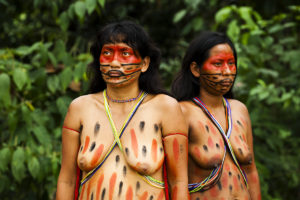
Two Matsés women in traditional dress and body paint Alicia Fox Photography
In an interview with noted conservation journalist Rhett A. Butler, Dr. David Fleck, Acaté’s Field Coordinator, talks about his history of living with the Matsés people in the deep Amazon rainforest. Fleck shares his perspective of life in the Amazon, its threats, and Acaté’s work. Originally posted here.
Tribes in the Amazon are increasingly exposed to the outside world by choice or circumstance. The fallout of outside contact has rarely been anything less than catastrophic, resulting in untold extinction of hundreds of tribes over the centuries. For ones that survived the devastation of introduced disease and conquest, the process of acculturation transformed once proud cultures into fragmented remnants, their self-sufficiency and social cohesion stripped away, left to struggle in a new world marked by poverty and external dependence.
In the deepest recesses of the Amazon, remaining tribes struggle to retain their cultural identity and self-sufficiency in a profoundly-shifting world. Such is the case with the Matsés – or Jaguar People – that live along the Javari river and its tributaries in Peru and Brazil. A tribe of fierce warriors permanently contacted only in 1969, the Matsés are perhaps best-known for their facial tattoos, ceremonial practices, and use of toxins from giant tree frogs as a stimulant for hunting expeditions.
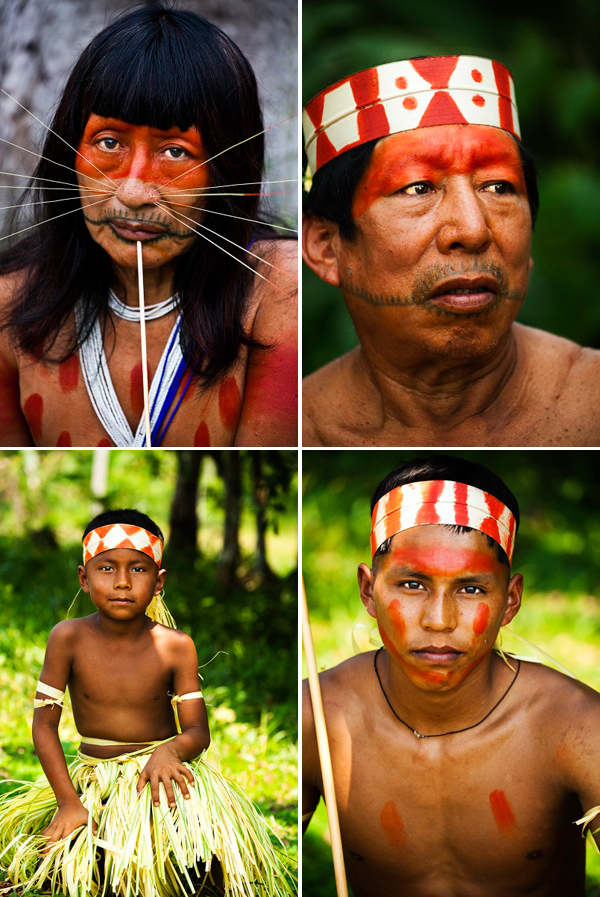
Portraits of Matsés. Photo by Alicia Fox
While most Matsés continue to live fairly traditionally, depending on wild game and fish as their primary food source, many increasingly rely on goods from non-indigenous villages and towns, creating need for Matsés to find sources of money to participate in the cash economy. Discrimination and outside influences have led many young Matsés to lose interest in, feel ashamed by, and even outright resent their culture. As with many other indigenous peoples worldwide, the Matsés struggle against resource and land grabs by petroleum, logging, and mining interests.
Few outsiders understand the challenges facing the Matsés better than David Fleck, a linguist who has worked with the tribe for the better part of two decades. Dr. Fleck in fact lives in one of the most remote Matsés villages, farming a small jungle garden and living a traditional lifestyle. He is married to a Matsés woman and has two sons. Fleck has written a grammar of their language, co-authored the definitive book of their culture (which he translated into their own language), and has published over 30 scientific articles on Matsés language, culture, and ethnobiology.
Today Fleck, working with Acaté Amazon Conservation, an NGO operating in Peru, is developing programs to generate sustainable livelihoods for communities that enable Matsés to meet their basic needs, meanwhile protecting the traditional knowledge base upon which the tribe depends to maintain their self-sufficiency and minimize external dependence. Acaté Amazon Conservation, named after the indigenous term for the giant monkey tree frog used ceremonially by the Matsés, was co-founded in 2012 by physician-ethnobotanist Christopher Herndon, M.D. and sustainable agriculturalist William Park.
Fleck talked about the Matsés and his work with Acaté during a January interview with Mongabay.com.

Dave and his history instructor, Manuel Tumi
AN INTERVIEW WITH DAVID FLECK
Mongabay.com: What is your background and what first drew you to Matsés territory?
David Fleck: Before becoming a linguist, I was a zoology student at the Ohio State University in the early 1990’s. As part of an undergraduate honor’s thesis project, I carried out a trap-and-release study of the several local opossum species in a primary rainforest plot along the Ucayali River in Amazonian Peru.
There was a poorly-maintained footpath off a road from a town near my field research site to a Peruvian military outpost at the Peru-Brazil border called Colonia Angamos. When I had finished my field collection, I learned that the town baker was planning to take the over week-long trek along the footpath to Angamos. Having a few weeks before I needed to return to the States, and a desire to put into use my minor in Portuguese, I asked if I could tag along. Rather than taking me directly to Angamos on the Javari River, the baker took a side route, whereby we emerged from the forest at a Matsés village on the Gálvez River.
I didn’t even know at the time that there were Indians in the area. At that village, the chief received my very hospitably, asked about my research and invited me to continue my zoological work with them. I was so delighted with the Matsés and their village that I accepted. In 1994, I began a Master’s research project that inventoried mammalian diversity in the region as well as examined Matsés knowledge of local mammals and classification of rainforest habitats.

Fleck on his farm. Photo by David Fleck.
Mongabay.com: What was the area like back in the early 1990’s (e.g. access, deforestation, outside influence, etc)? How has it changed since then?
David Fleck: In the early 1990’s, the government had not yet began to build cement tin-roofed schoolhouses and there was only one motorized canoe in each village. Only a few men could communicate in Spanish and they had not yet begun to work timber in Matsés territory. Back then the Matsés were not interested in money, because they had little access to shops, so I compensated my hosts and helpers only with trade items like machetes, axes, fishhooks, tin pots, etc.
Today, the Matsés continue to be very traditional in several respects: they still procure almost all of their food from hunting, fishing, farming, and collection of wild food. They still speak Matsés as their primary means of communication, they continue to rely heavily on traditional medicinal knowledge, and the older Matsés retain most of their traditional knowledge and beliefs. However, now that there are many motorized canoes and the Matsés travel frequently to Colonia Angamos and the city of Iquitos. They have a lot more contact with non-tribal Peruvians. The younger Matsés are losing interest in their culture and are not learning their traditional knowledge.

Traditional Matsés ceremony. Courtesy of the Matsés community.

Traditional Matsés ceremony. Courtesy of the Matsés community.
Mongabay.com: What has been the evolution of your work in the region? (e.g. going from biology to linguistics)
David Fleck: After having spent a total of 20 months in San Juan doing my master’s field research, I knew that I wanted to continue spending long periods of time with the Matsés. I told my advisor that I wanted to do another ethnobiology project among the Matsés for my Ph.D. dissertation. My advisor responded that it would be nearly impossible to find a job if I did so. Biology departments were not interested in hiring professors specialized in ethnobiology and anthropology departments were not interested in hiring professors with a degree in zoology. He suggested that if I wanted to continue working with the Matsés that I should switch to anthropology or linguistics. Since I had enjoyed learning to speak Matsés, I chose linguistics. In 1997, I received a scholarship to study linguistics at Rice University in Houston, and spent another two years doing research at San Juan to write a grammar of the Matsés language as my Ph.D. dissertation.
When I graduated in 2003, I was hired as a postdoctoral research fellow at La Trobe University in Melbourne, Australia and spent another couple years doing research on the Matsés language at San Juan. After having written a series of academic articles on the Matsés language and a Matsés-Spanish dictionary, I was offered a permanent faculty position at La Trobe University. However, this job would not allow me to conduct more than about two months of field research per year. I reflected on the fact that the only reason why I had gotten into linguistics was because I wanted to be among the Matsés, and so decided to quit my job and start a family among the Matsés.

Fleck’s house at Estirón. Photo by David Fleck.
Mongabay.com: You are married to a Matsés woman. Has that changed how you are viewed in the community?
David Fleck: When I was a researcher, I made many good friends among the Matsés. An old woman once felt sorry for me because I did not have a family, so she adopted me and called me “son.”’ Some of her sons and other close relatives subsequently also called me by kinship terms. However, these kinship relations were not considered real. Once I was married, however, ALL the Matsés became my kin. Through their relation with my wife Dina, all the Matsés can determine a kin relation to me. So this definitely changed my status among the Matsés, considering that the term “Matsés” also means “kinsman” and that kin relations are the most important thing in their culture. Though obviously I am not a real Matsés, one could say that now I am officially an honorary Matsés, with the corresponding privileges and obligations. Now I have two sons, who are considered to be true Matsés.

Mongabay.com: What is your current lifestyle? (e.g. Do you spend most of your time in the forest? How do you make a living?)
David Fleck: When I first got married and began to live permanently among the Matsés in 2008, I spent most of my time hunting, fishing, farming, collecting wild foods, and working on my house, like most Matsés. I did that for two years until my savings ran out. As it turned out, my in-laws looked to me to purchase things like salt, soap, ammunition, flashlight batteries, machetes etc., which they now require but have few opportunities to acquire money to purchase. So despite my preference for traditional subsistence activities, I have taken on several occupations that allow me to earn some money to contribute to my extended family’s necessities. As they told me, “the best way to contribute is to do what one does best,” and in the end, I am only a mediocre hunter. Among these activities is a project, funded by the Hans Rausing Endangered Languages Documentation Programme, documenting the oral history of the Matsés. I am also working for the Peruvian ministry of education writing pedagogical materials for the Matsés bilingual education program. In the end, I still have time to do my farm work, but I don’t get to go hunting as often as I would like.
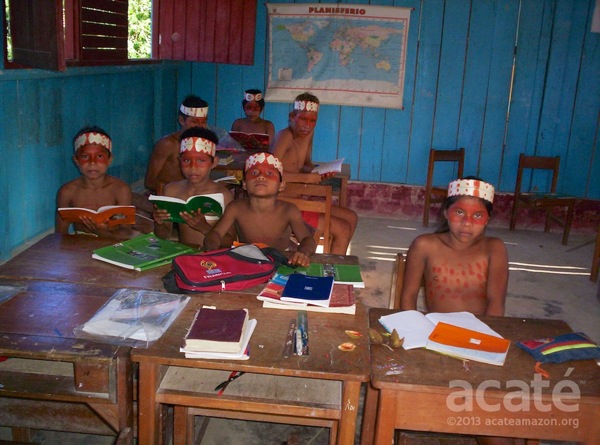
Matsés students dressed up in traditional garb. Photo by David Fleck.
The Matsés
Mongabay.com: How many Matsés are there and where is there territory?
David Fleck: Today, the Matsés number approximately 3300 and live along the Javari river and its tributaries in the remote region that divides Amazonian Peru and Brazil. About two-thirds live in Peru within the department of Loreto, and the remainder third live within the Brazilian state of Amazonas. In Brazil, the Matsés are known better as Mayoruna, a term that was also used to designate the Matsés in Peru until the 1980s.
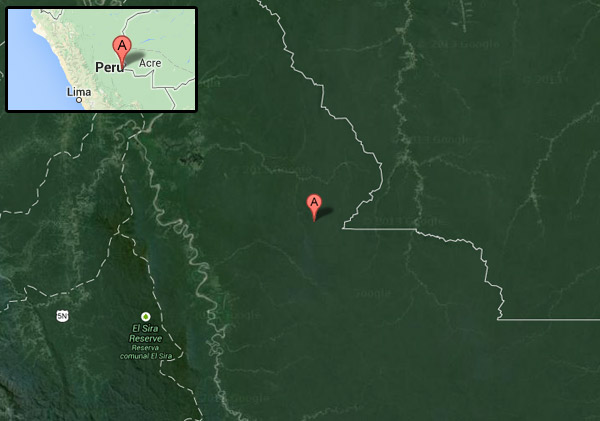
Matsés territory. Courtesy of Google Earth
Mongabay.com: What is the state of the Matsés today?
David Fleck: The Matsés established peaceful contact with the Brazilian and Peruvian national cultures in 1969, so they are still relatively traditional: most still practice traditional subsistence strategies; all still speak their language; and much of their traditional beliefs remain intact. But this is rapidly changing as younger generation loses interest and pride in their culture.
Mongabay.com: Does the tribe operate as a single political unit or are there large variances within the group, like some villages that less traditional than others?
David Fleck: Although the Peruvian and Brazilian Matsés are politically completely separate, they visit each other, intermarry, and generally consider themselves to all belong to the same tribe. There is a tendency for the more remotely-located villages to be more traditional, but overall, there is not a wide difference among the different villages.

Matsés boy carrying firewood. Photo by David Fleck.
Mongabay.com: Are there any voluntarily isolated or “uncontacted” Matsés?
David Fleck: There are uncontacted groups in Brazil near Matsés territory, but their identity is unknown. It is possible that some speak languages similar to that of the Matsés, but the Matsés say that all their kin are accounted for among the contacted Matsés.
Mongabay.com: Are there practices that set the Matsés apart from other indigenous groups in the region?
David Fleck: Because Matsés were contacted so recently and live in such a remote and inaccessible area, they are much more traditional than other ethnic groups in the area (other than the uncontacted groups). Their culture is similar to the traditional culture of other related tribes of the Panoan-linguistic family in the region. They are known for their facial tattoos, their elaborately-crafted arrows, and their use of frog poison as emetic. Before peaceful contact, the Matsés were notorious for raiding other Indians and non-Indians at the periphery of their territory and capturing the women to take as wives.
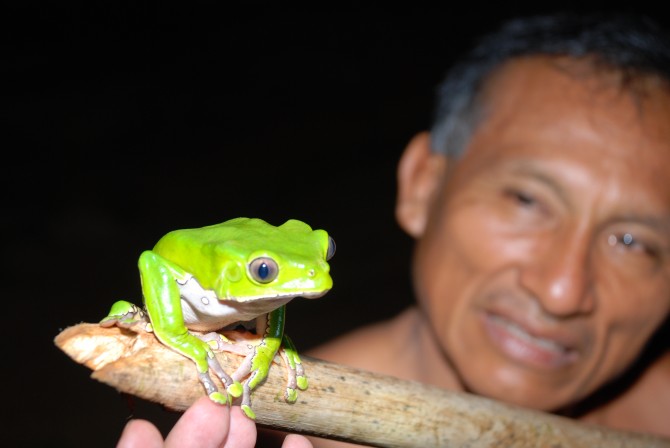
The giant monkey frog (Phyllomedusa bicolor), known locally as acaté, is used by the Matsés in hunting rituals. The secretions, rich in a diversity of bioactive peptides, are administered directly into the body through application onto fresh inflicted burn wounds. Within moments, the toxins induce intense cardiovascular and autonomic responses, ultimately leading to a state of altered consciousness and heightened sensory acuity. ©Acaté
Mongabay.com: How is the Matsés way of life changing? Are there threats to their traditional ways of life?
David Fleck: One factor that threatens the Matsés is discrimination. Many Peruvians, especially the ones who live near Matsés territory are racist and speak negatively of the Matsés and their culture. Consequently, many young people have come to feel ashamed of their culture and try to hide their identity as Matsés when they are outside of their communities. For the most part, the younger generation has little interest in Matsés traditional knowledge. However, the older generation still retains a deep pride in their culture.
With this in mind, I am involved in two projects. One is the writing of a book in the Matsés language about their oral history, which relates the heroic deeds of their ancestors, with the hope of instilling pride in the younger generation. The second project is writing, in conjunction with Acaté and Matsés elders, is a book in their language that documents the Matsés’ traditional medicinal plant knowledge. The book is a first step in an initiative that that will sponsor an apprenticeship program where Matsés medicine men will train young apprentices in traditional healing.
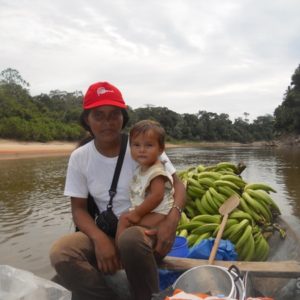
Fleck’s wife Dina and his son on the Jaquirana River. Photo by David Fleck.
Mongabay.com: Are younger Matsés leaving villages to pursue opportunities elsewhere?
David Fleck: Every year more young Matsés men are leaving the Matsés village to work or join the army. Some do not come back. However, most young people are still living among the Matsés.
Mongabay.com: Is Matsés territory being affected by deforestation, energy extraction, illegal logging and mining, or industrial agriculture? Does the government of Peru recognize the Matsés land rights?
David Fleck: A Canadian petroleum company is trying to enter Matsés territory to drill for oil, despite the fact that the Matsés have stated clearly that they do not want oil extraction on their land. The Peruvian government has granted the Matsés title to about half of their ancestral territory in Peru, and made the other half into a national park. However, the government retains mineral rights in Matsés territory, and they have granted the Canadian company access to Matsés territory.
Mongabay.com: What is Acaté’s approach to conservation?
David Fleck: Acaté believes empowering indigenous peoples is the most effective and enduring approach for rainforest conservation. Tribal peoples understand and value the rainforest because they depend on it. This relationship extends beyond a utilitarian reliance—there is a spiritual link to the forest, an interconnectivity of all its inhabitants. It is not a coincidence that the remaining tracts of pristine rainforest in the Neotropics overlap with areas of indigenous inhabitation.

Matsés children. Photo by Alicia Fox

Matsés children getting ready for a traditional ceremony. Photo courtesy of the Matsés Community.
Mongabay.com: What are Acaté’s conservation projects?
David Fleck: The Acaté team and the Matsés leadership have worked closely together to develop a three-point plan of action that is welcomed by the Matsés communities and is being implemented in a logical, sequential manner.
First, we are developing programs that provide long-term, sustainable revenue to the communities, enabling them to buy the simple items they need for their homes. Conservation is not about telling peoples what activities they shouldn’t engage in but rather in developing tangible economic alternatives where few or none exist. To this end, Acaté assists the Matsés in the sustainable harvesting and marketing of natural products such as renewable tree resins copaiba and sangre de grado. By harvesting valuable tree resins, they can immediately earn the income they need and be free of destructive and dangerous timber-cutting jobs.
Secondly, we are supporting indigenous systems of health such as medicinal plant knowledge before they are irrevocably lost. This will maintain their self-sufficiency and alleviate long-term dependency on the limited external medical resources available in their remote villages. Loss of shamanic knowledge can be counteracted with inauguration of an internship program for the youth to learn the wisdom of their elders as well as through development of an encyclopedia of their medicinal plant knowledge. This resource is being produced in the Matsés language for repository within their communities. It will not be translated into Spanish or English to protect their knowledge against bioprospecting by outside parties.
Thirdly, we have developed an innovative farm in my village of Estirón to pilot and share approaches that promote nutritional diversity, enhance soil fertility, and abundance. Small-scale agriculture is responsible for large levels of Amazonian deforestation, but is one of the least addressed issues in conservation today. These agricultural techniques seek to modify the slash-and-burn farming practices that no longer work for larger and increasingly permanent settlements.
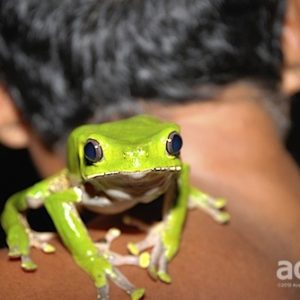
The giant monkey tree frog (Phyllomedusa bicolor), for which Acaté Amazon Conservation is named. ©Acaté
Mongabay.com: How can people in the United States help further Acaté’s work?
David Fleck: The Matsés were contacted in the past half-century and live in some of most pristine rainforests in the world. What makes our projects so high impact is that their forests and culture have remained intact until recently, providing all of us a rare opportunity in the 21st century to be proactive.
But the world of the Matsés is changing. Predatory oil companies are pressing to exploit the large reservoirs of natural gas in Matsés’ territory, the extraction of which—if recent history is any precedent—will poison their waters and sicken their children. The lure of the city is pulling younger Matsés away from their homes into a reality of poverty and exploitation. Matsés who do remain need cash to secure basic material goods which forces them into to the only economic opportunities locally available: hunting bushmeat and/or logging. Both practices threaten to deplete their already-strained forests.
It is easy to undervalue just how much impact people outside in the United States and abroad can have. It is humbling that an investment of comparatively few resources can change so much the trajectory of a proud people struggling for their cultural survival amidst a profoundly shifting world. Acaté strives to be a vehicle of positive change in the heart of the Amazon rainforest. We operate with the highest level of transparency and with minimal operating overhead. If you are passionate about the rainforest and want to make a difference in the lives of its indigenous protectors, please take a moment to learn more about our work. Consider supporting our efforts with a donation today!
Disclosure: Mongabay.org presently serves as the fiscal sponsor for Acaté Amazon Conservation and Rhett Butler sits on its board.
